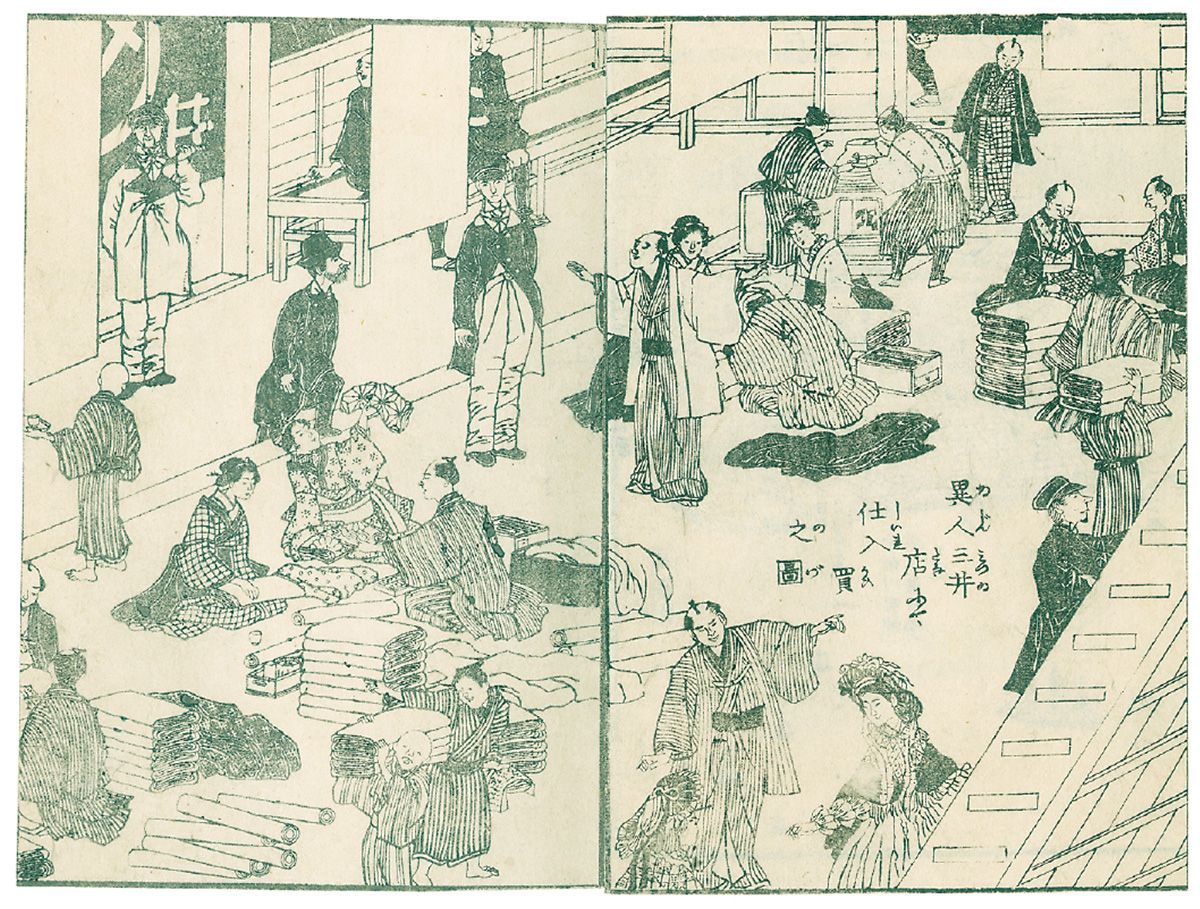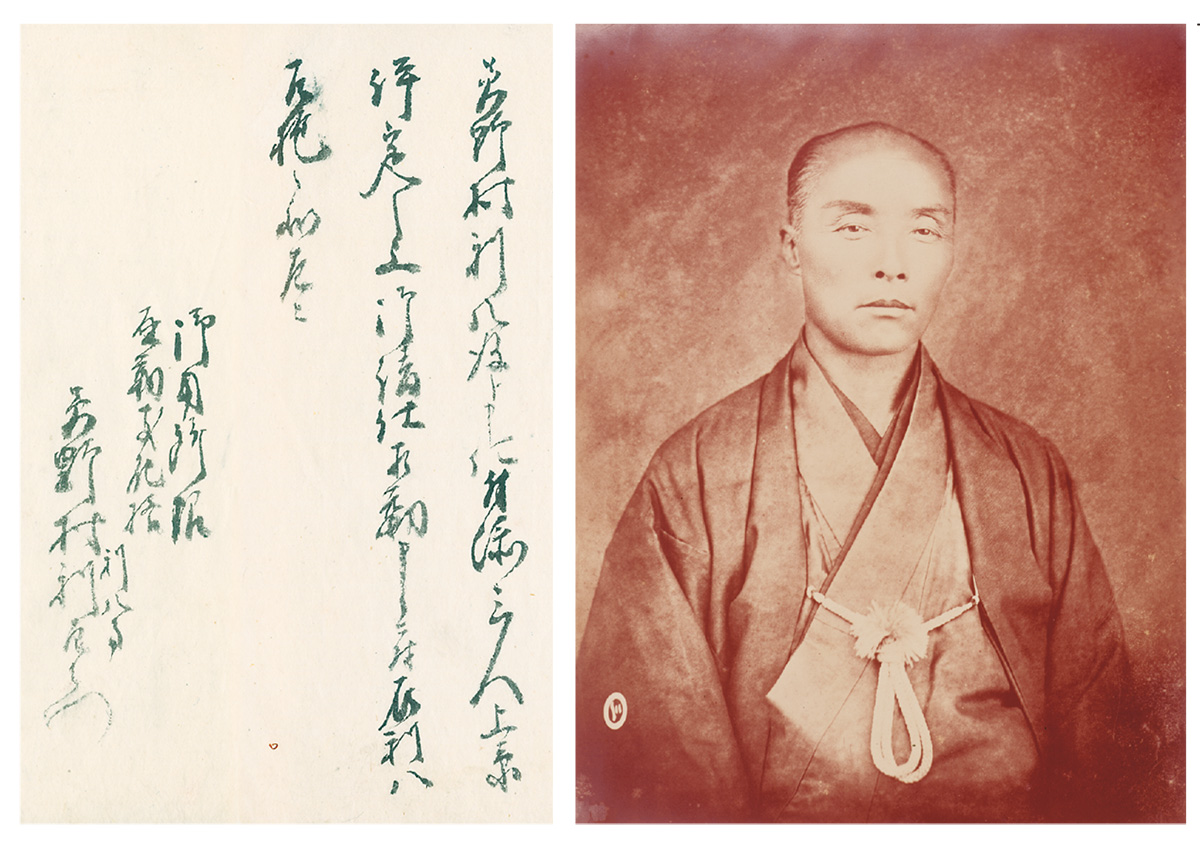22 Opening to the West and the Shogunate’s Extortion

Opening a Shop in Yokohama, Handling Trade for the Shogunate
In 1858, with the signing the Treaty of Amity and Commerce (Five-Party Treaty of Ansei) with several other countries, Japan abandoned its policy of isolation and opened to the world. In June (lunar calendar) of the following year, Yokohama opened as a trading port. At the request of the shogunate, Echigoya opened a shop in Yokohama as a branch of its Edo kimono shop.
In addition to sales of kimono fabric, the Yokohama shop executed trade transactions on behalf of the shogunate. Echigoya received large amounts of capital from the shogunate and expedited trade transactions as required. However, the Yokohama shop diverted the funds deposited, using them for working capital in the kimono business, loans to raw silk merchants, speculation in Western silver markets, and other uses. In the process, the shop incurred significant losses. In 1867, against shogunate deposits amounting to more than 220,000 ryo in gold and 40,000 dollars in silver coin, only around half that amount remained.
Financial Extortion and Mitsui’s Response
The latter days of the shogunate found it in urgent need of funds, including for naval defense, the Choshu War and other military expenditures as well as shogun Iemochi’s visit to Kyoto. Mitsui was hit several times with financial extortion (→21), but in 1866, was ordered to “lend” the shogunate the huge amount of 1,500,000 ryo. It is thought that this amount may have been demanded partly due to the Yokohama shop’s misuse of shogunate funds. The Omotokata took action after becoming aware of the shop’s misconduct. It first negotiated the amount demanded by the shogunate down to 500,000 ryo (and subsequently, 180,000 ryo), and successfully requested that payment be extended over several years.
In addition, the shogunate’s office of accounting (Kanjosho) gave a new order to Mitsui. The order was to lend money to wholesalers in Edo, using their products as collateral. This was not very profitable, and having already had so many orders from the shogunate, Mitsui wanted to decline as much as possible. However, if it refused to cooperate, the shogunate might demand full repayment of shogunate funds held on deposit. As such, Mitsui had no choice but to agree to the order.
Establishing the Goyosho
In 1866, the Omotokata established a department called the Goyosho (purveyor’s office) to carry out lending to the Kanjosho. This new entity also took over the Yokohama shop’s handling of public funds, playing a role in shogunate finances by handling most of the revenue and expenditures relating to the shogunate in Edo and Yokohama.
The fall of the shogunate and the stationing of troops by the new government in Edo ended the provision of financial services to the shogunate, but it is thought that the Goyosho continued to supply financial support to Edo wholesalers through lending. As relations between Mitsui and the new government gained a solid footing, the Goyosho began providing financial services to the government, and this business became as important as those of Mitsui’s kimono fabric and financial divisions.
Minomura Rizaemon
Beginning around this time, a man named Minomura Rizaemon (→Fig. 22c) began to play an important role in Mitsui history. Minomura ran a money exchange house and dealt frequently with the shogunate’s commissioner of the Kanjosho, Oguri Tadamasa. When Mitsui needed to negotiate a reduction in the shogunate’s demand for 1,500,000 ryo, they turned to Minomura to intercede with Oguri on Mitsui’s behalf, leading to success in the negotiations.
Mitsui then hired Minomura to handle the Goyosho’s transactions involving government funds (→Fig. 22c). It was extremely rare for Mitsui to bring in someone from the outside to handle a task, as it did in this case.

A woodblock print depicting the newly opened harbor of Yokohama. The print is undated, but a colorful Yokohama is shown crowded with goods and people moving about as Japanese and foreigners mingle. The Mitsui crest is displayed prominently on the walls of the shop at center left.
Mitsui’s Yokohama shop handled kimono fabric sales and transactions involving shogunate funds. Correspondence from the Yokohama shop is filled with descriptions of visiting foreigners (→Fig. 22b) and rumors of the situation in America amid its ongoing Civil War, a clear indication that the sales staff could feel the advent of a new era. But fabric sales were poor, and the shop was shuttered after three years of operation.


Minomura’s father was a daimyo retainer in Dewa Province (today’s Yamagata Prefecture). When he was a child, Minomura’s father abandoned his position and became a masterless samurai, and it is said that together they wandered the country. At 25, he became the adopted son-in-law of a sugar and oil merchant Kinokuniya in the Kanda district of Edo, taking the name, Minokawa Rihachi. Through hard work he amassed significant wealth, entering the money exchange business by buying shares in an exchange house. The document shown above is a record of a meeting of the Omotokata held on November 2, 1866 (lunar calendar). There it was decided to hire him for a senior position in the Goyosho. At the same time, he changed his name to Minomura Rizaemon, and this is noted.
